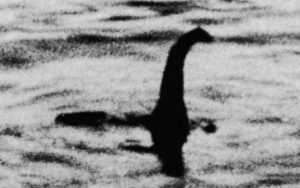The Loch Ness Monster, also known as “Nessie,” is a legendary creature said to inhabit Loch Ness, a large freshwater loch in the Scottish Highlands. The legend of Nessie has been the subject of numerous sightings, photographs, and even scientific expeditions. But the existence of the creature remains unproven.
First Sighting
The first recorded sighting of Nessie was in 565 AD, when a man named St. Columba is said to have encountered a creature in the River Ness while on a mission to convert the Picts to Christianity. According to the legend, the creature had attacked a man in the river. But Columba was able to ward it off by making the sign of the cross and commanding it to “go back with all speed.”
Over the centuries, there have been many reported sightings of Nessie. Funny enough it wasn’t until the 20th century that the legend gained widespread popularity. In 1933, a couple named Mr. and Mrs. Mackay claimed to have seen “an enormous animal rolling and plunging on the surface” of the loch. This sighting was followed by many others, and soon Nessie became a household name.
Famous Photo

The most famous photograph of Nessie was taken in 1934 by a surgeon named Robert Kenneth Wilson. The photo, known as the “surgeon’s photograph,” shows a long, serpentine creature with a small head and humps protruding from the water. The photo was widely published in newspapers and magazines, and helped to cement Nessie’s place in popular culture.
Despite numerous attempts to locate Nessie, no definitive proof of the creature’s existence has ever been found. Some scientists believe that the sightings are simply misidentifications of known animals, such as otters or large fish. Others speculate that the legend of Nessie is a hoax or a figment of people’s imaginations.
Recent Sightings
In recent times, reports of Loch Ness monster sightings continue to captivate the imagination and stir debate among enthusiasts and skeptics alike. Modern-day accounts of the mysterious creature tend to surface sporadically, often accompanied by alleged photographic or video evidence. This has further fueling the intrigue surrounding the Loch Ness monster. Witnesses describe encounters with a large, serpentine creature lurking beneath the dark and enigmatic waters of Loch Ness, its humped back and long neck breaking the surface momentarily before vanishing into the depths. While some remain convinced that these sightings offer compelling proof of the existence of a prehistoric marine creature. While others attribute the sightings to misidentifications, optical illusions, or simple hoaxes.
In Conclusion
Despite the lack of concrete evidence, the legend of Nessie continues to capture the imaginations of people around the world. The loch remains a popular tourist destination. The creature has been the subject of countless books, movies, and TV shows. Whether Nessie is real or not, the legend is sure to endure for generations to come. Regardless, the legend of the Loch Ness monster endures, perpetuating the allure of this ancient enigma.